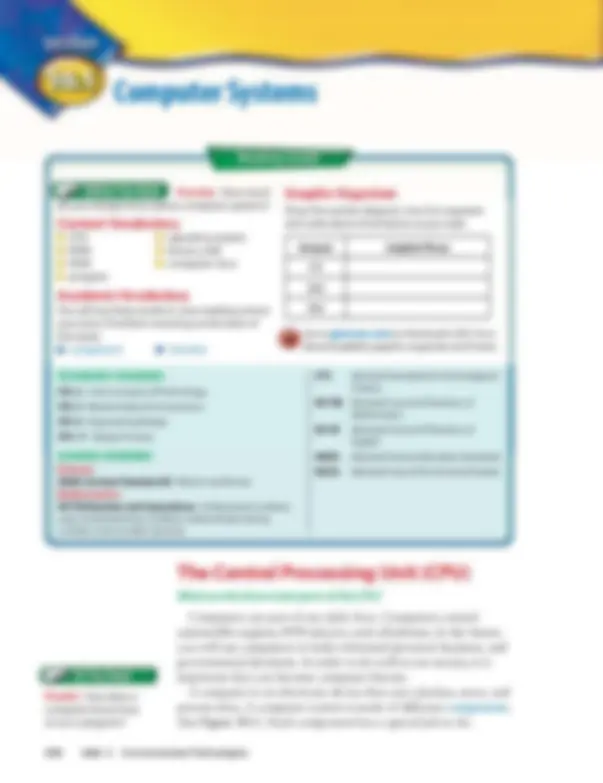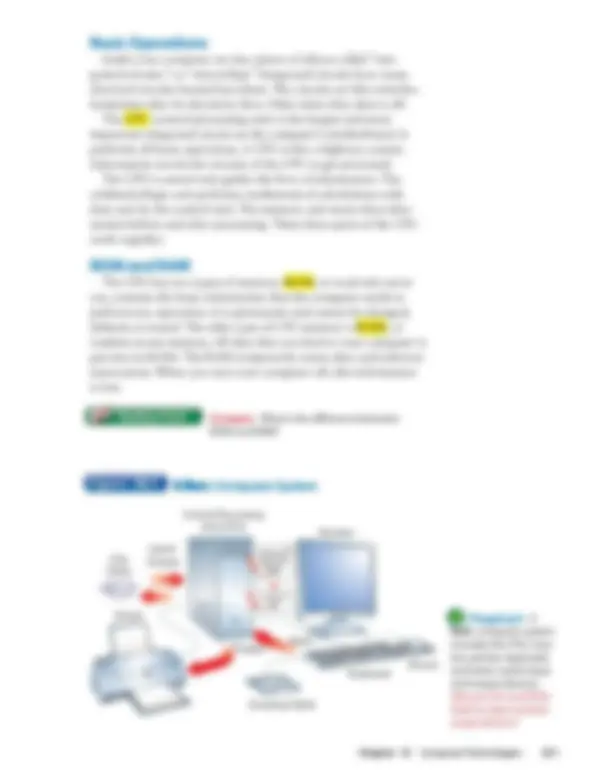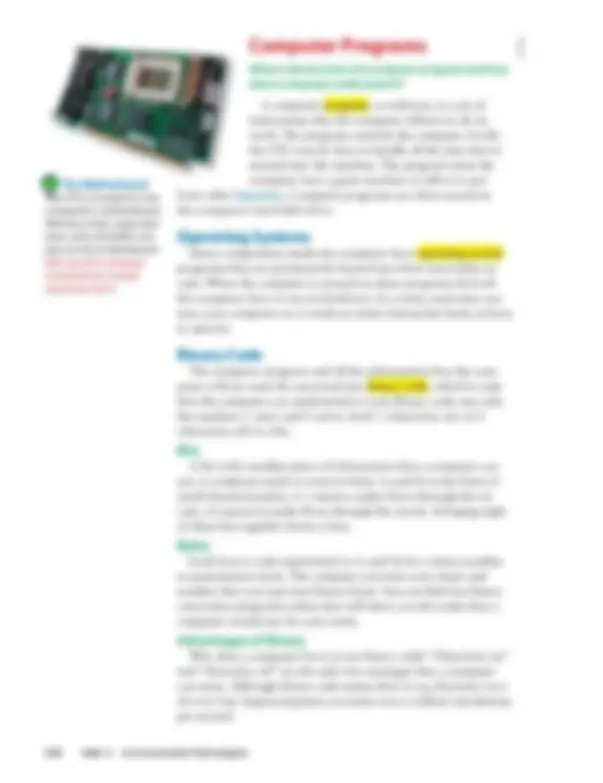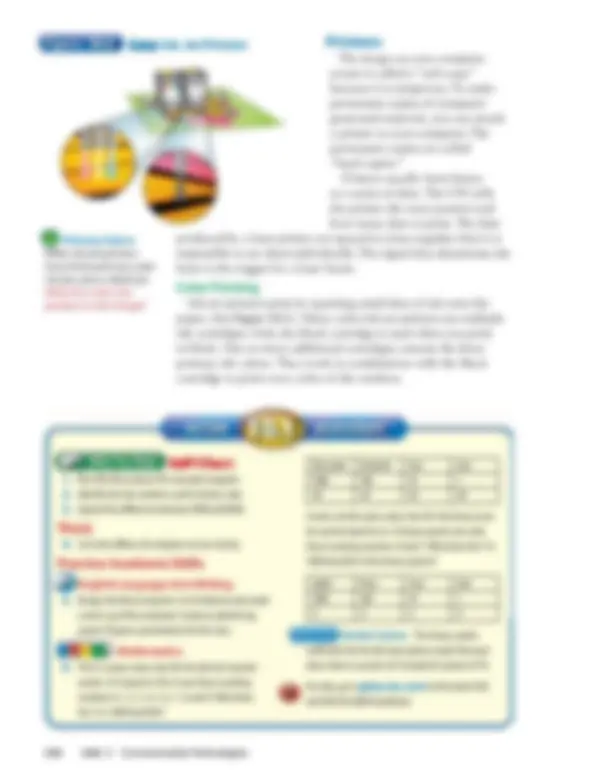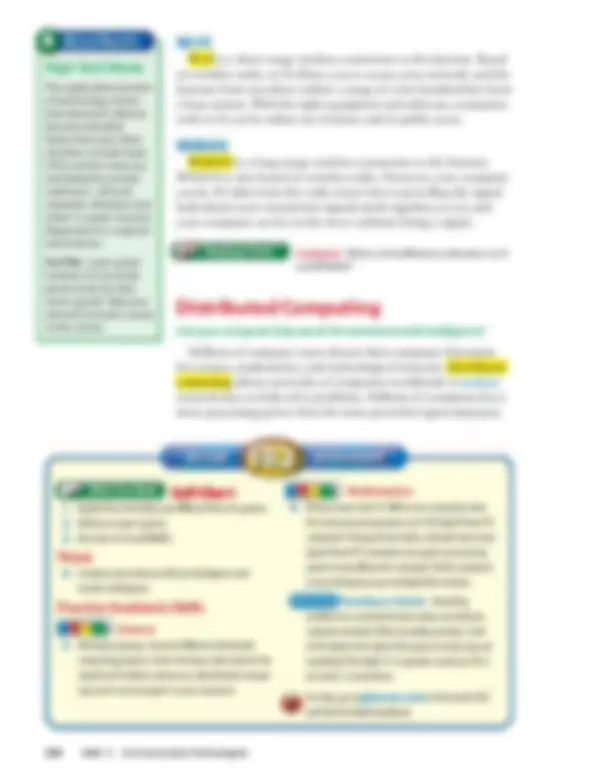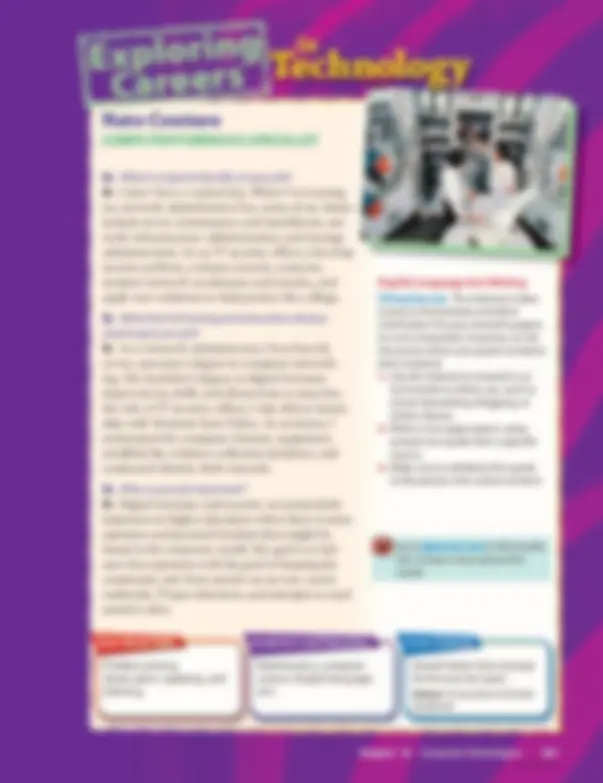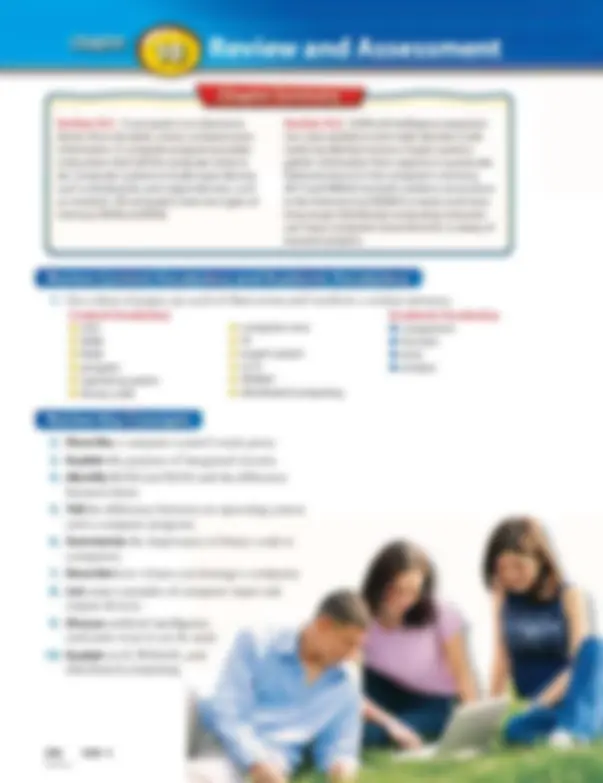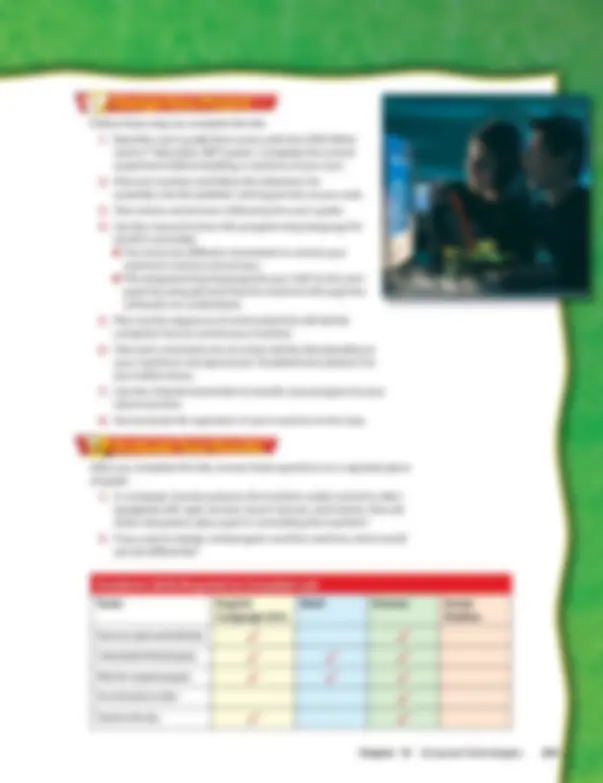Download Understanding Computer Systems: Main Components, Binary Code, and Input/Output Devices and more Study notes Communication in PDF only on Docsity!
10.1 Computer Systems
10.2 Computers on the Cutting Edge
Identify the main parts of a computer system. Explain why binary code is important to computer function. Name several computer input and output devices. Describe artificial intelligence and identify ways in which it can be used. Discuss wi-fi, WiMAX, and distributed computing.
Explore the Photo
Anywhere You Want It The first computers were the size of large rooms. They performed simple operations and consumed massive amounts of energy. Today’s personal comput- ers are powerful devices that fit on your lap and can connect to the Internet wirelessly. What part of this computer is the input device?
Computer
Technologies
208 Unit 3 Communication Technologies
Program a Computer to
Control a Machine
At the end of this chapter, you will be asked to build a motorized robotic machine. You will then write a program that will control your robot. Get a head start by using this checklist to prepare for the Technology Lab.
PROJECT CHECKLIST Do some Internet research on robots that other students have created. Read the LEGO Mindstorms™ Education NXT system user’s guide. Do the control experiment that comes with the system.
209 SuperStock
Monitor
Central Processing Unit (CPU)
CDs, DVDs
Printer
Keyboard
Drawing Tablet
Mouse
Input/ Output
Output
Input
Arithmetic/ logic unit (ALU)
Control unit
Basic Operations
Inside your computer are tiny pieces of silicon called “inte-
grated circuits,” or “microchips.” Integrated circuits have many
electrical circuits burned into them. The circuits act like switches.
Sometimes they let electricity flow. Other times they shut it off.
The CPU (central processing unit) is the largest and most
important integrated circuit on the computer’s motherboard. It
performs all basic operations. A CPU is like a highway system.
Information travels the circuits of the CPU to get processed.
The CPU’s control unit guides the flow of information. The
arithmetic/logic unit performs mathematical calculations with
data sent by the control unit. The memory unit stores that infor-
mation before and after processing. These three parts of the CPU
work together.
ROM and RAM
The CPU has two types of memory. ROM , or read-only mem-
ory, contains the basic information that the computer needs to
perform any operation. It is permanent and cannot be changed,
deleted, or erased. The other type of CPU memory is RAM , or
random access memory. All data that you feed to your computer is
put into its RAM. The RAM temporarily stores data and software
instructions. When you turn your computer off, this information
is lost.
Compare What is the difference between ROM and RAM?
10.1 A Basic Computer System
Plugging In A basic computer system includes the CPU, mon- itor, printer, keyboard, and other useful input and output devices. Why are CDs and DVDs listed as input and also output devices?
Chapter 10 Computer Technologies 211
Computer Programs
What is the function of a computer program and how
does a computer understand it?
A computer program , or software, is a set of
instructions that the computer follows to do its
work. The program controls the computer. It tells
the CPU exactly how to handle all the data that is
entered into the machine. The program turns the
computer into a game machine or tells it to per-
form other functions. Computer programs are often stored on
the computer’s hard disk drive.
Operating Systems
Many components inside the computer have operating system
programs that are permanently burned into their microchip cir-
cuits. When the computer is turned on, these programs first tell
the computer how to run its hardware. In a sense, each time you
turn your computer on, it reads an entire instruction book on how
to operate.
Binary Code
The computer program and all the information that the com-
puter will use must be converted into binary code , which is code
that the computer can understand or read. Binary code uses only
the numbers 1 (one) and 0 (zero). Each 1 (electricity on) or 0
(electricity off) is a bit.
Bits
A bit is the smallest piece of information that a computer can
use. A computer sends or receives these 1s and 0s in the form of
small electrical pulses. A 1 means a pulse flows through the cir-
cuit; a 0 means no pulse flows through the circuit. Stringing eight
of these bits together forms a byte.
Bytes
Each byte is code represented as 1s and 0s for a letter, number,
or punctuation mark. The computer converts every letter and
number that you type into binary bytes. You can find free binary
conversion programs online that will show you the codes that a
computer would use for your name.
Advantages of Binary
Why does a computer have to use binary code? “Electricity on”
and “electricity off” are the only two messages that a computer
can sense. Although binary code seems slow to us, electricity trav-
els very fast. Supercomputers can make over a trillion calculations
per second.
The Motherboard The CPU is located on the computer’s motherboard. Memory chips, expansion slots, and controllers are also on the motherboard. Why would a computer manufacturer include expansion slots?
212 Unit 3 Communication Technologies
PhotoDisc
Anti-Virus Software
The FBI reports that viruses and spyware crimes, and the soft-
ware to protect against them, cost billions of dollars each year.
Anti-virus program packages usually include a firewall program
to block known dangers and a virus program to find and destroy
viruses that do get into your computer. These programs must be
updated frequently to protect against new attacks.
Recall Why is binary code important to the functioning of computers?
Disk Drives
What is the purpose of a computer disk drive?
The computer’s disk drive allows data to be written to stor-
age (recorded memory) or read from storage. If you were to look
inside a hard-disk drive case, you would see a stack of round
metal-oxide platters. Hard drives use electromagnetism to write
messages onto these disks. When the playback head passes along
the disk, it picks up this magnetic coded message. The message is
then converted back into an electronic signal.
CDs and DVDs
Commercial CDs and DVDs contain information in binary
code. This code has been microscopically burned into the plastic
disk as tiny pits. A laser on your CD/DVD drive reads this.
DVD drives contain a laser that can change its focus, allowing
it to read the digital information on different layers of the DVD.
High Definition (HD) drives increase storage by using a narrower,
blue-ray laser instead of the red laser in standard CD/DVD drives.
Computers without Computers
Imagine life without personal computers. All you need is a small handheld device to access online programs and store all of your files on the Internet. Companies like Google already offer photo storage, word process- ing, and spreadsheet applications as free Web-based services. In the future, you may be able to do every- thing you now do on a personal computer with very little hard- ware. What might be the advantages and disad- vantages of using online software and online storage space?
Go to glencoe.com to this book’s OLC for answers and to learn more about online software and storage.
Portable Music Library An iPod or MP3 player has a hard drive that can store and play audio and sometimes video files. When connected to a computer, is an MP3 player an output device or an input device?
214 Unit 3
Jim Craigmyle/Corbis
Input Devices
What kinds of devices send data to computers?
Any device that can send information to a computer is
an input device. The list includes disk drives, keyboards
(for computers and musical instruments), mouses,
joysticks, scanners, drawing tablets, touch screens, digital
cameras, and video cameras. Input devices also include
specialized equipment used in scientific research, engineer-
ing, medicine, industry, and music.
Converting Input
Each input device must have a way of converting its data
into the binary code that a computer can process. When
you press down on a keyboard letter, you cause contacts
that are under the key to send the binary code for that
letter. This coded message is sent into a memory location
by the CPU and onto your computer screen. The CPU
controls and uses this binary information according to the
instructions provided by the program.
Input and Computer Screens
The surface of a computer screen is divided into horizontal and
vertical coordinates. They are similar to the horizontal and vertical
coordinates on a world map that we call latitude and longitude.
The computer uses these coordinates to locate things on the screen.
When you move a mouse, the row and column location of the
pointer changes. The input device converts that movement into a
binary electronic signal that the computer can understand.
List What are some examples of input devices?
Output Devices
What devices are used for output?
Any device that can receive information from a computer is an
output device. This includes the computer’s disk drives, monitor,
printers, speakers, sound card, video card, headphones, and music
synthesizers. Many other specialized output devices have been cre-
ated for use in science, engineering, medicine, and industry.
Input/Output Devices
Did you notice that disk drives and music synthesizers are also
included on the input device list? Any device that can send and
also receive data from a computer is considered to be an input/
output device.
Electronic Music This synthesizer is both an input and an output device. MIDI (Musi- cal Instrument Digital Interface) technology allows computers and electronic musical instruments to commu- nicate. How do you think the musical information changes as it is sent on to the computer’s CPU?
Chapter 10 Computer Technologies 215
SuperStock Royalty Free
Computers on the Cutting Edge
Connect What will computers be like in the future?
Content Vocabulary AI expert system wi-fi WiMAX distributed computing
Academic Vocabulary error analyze
Graphic Organizer Draw the section diagram. Use it to organize and write down information as you read.
Go to glencoe.com to this book’s OLC for a downloadable graphic organizer and more.
TECHNOLOGY STANDARDS
STL 1 Characteristics & Scope of Technology STL 7 Influence on History STL 9 Engineering Design STL 11 Design Process STL 17 Information & Communication Technologies
ACADEMIC STANDARDS
English Language Arts NCTE 11 Participate as members of literacy communities Science NSES G Historical Perspectives
STL National Standards for Technological Literacy NCTM National Council of Teachers of Mathematics NCTE National Council of Teachers of English NSES National Science Education Standards NCSS National Council for the Social Studies
Artificial Intelligence
What is artificial intelligence?
How do you think the computer might evolve during your life-
time? If computers continue to develop at their current rate, will
they surpass humans at most tasks?
People sometimes talk about the intelligence of computers.
They are not really intelligent at all. A computer gets no satis-
faction when it solves a problem. It can only run programs and
process data. Section 10.1 explains how computers follow instruc-
tions, so that computer error is often really human error.
“Thinking” computers are, at this time, just “science fiction.”
Distributed Computing Projects
1. ______________________________________ 2. ______________________________________ 3. ______________________________________
Infer Do you think computers make deci- sions on their own?
Chapter 10 Computer Technologies 217
AI Programs
AI (artificial intelligence) programs, however, give the impres-
sion that a computer can think. The programmer has provided
the computer with a number of answers that will be triggered by
certain requests.
Video and Computer Games
In video and computer games, AI programs control the char-
acters who are not controlled by the player. These characters
seem to make their own decisions. If the programmer has given
the computer a wide range of responses, the computer-controlled
characters will seem more real and complex.
Expert Systems
Some artificial intelligence programs are called expert systems.
In these systems, information from experts in a particular field
is stored in a computer’s memory. When the computer is asked a
question, it uses this information to answer correctly. A medical
expert system, for example, might diagnose diseases. If a doctor
or nurse provides it with a list of symptoms, it will match that list
against all known diseases.
Deep Fritz
In 2006, Vladimir Kramnik, the world chess champion, played
Deep Fritz, which is now considered the world’s top chess com-
puter program. Deep Fritz is capable of “thinking” millions of
moves per second. How many moves a human can examine per
second is unknown. Deep Fritz won this competition, which raises
the question: Will there come a time where human intelligence
cannot match the AI programs it has created?
Immobots
Another new development in AI is immobots, or “immobile
robots.” Developed by researchers at the Massachusetts Institute
of Technology, most immobots do not move around, but they
control a machine that probably does.
Language Challenged U.S. military troops sent to other countries are equipped with hand- held computers that use speech recognition software. When a word in English is spoken into the Phraselator, it shows the word on a small screen, then translates it and broadcasts it in the chosen language.
Apply Do you think a common language spoken everywhere in the world would be a good thing? Write a paragraph giving rea- sons for your opinion.
Human vs. Machine World chess champion Vladimir Kramnik tries to prove the superiority of the human brain over the computer brain. Deep Fritz, the computer, won the match. If Deep Fritz is an expert system, what kind of experts contributed to its memory?
218 Unit 3 Communication Technologies
AFP/Getty Images
Wi-Fi
Wi-fi is a short range wireless connection to the Internet. Based
on wireless radio, wi-fi allows you to access your network and the
Internet from anywhere within a range of a few hundred feet from
a base station. With the right equipment and software, computers
with wi-fi can be online out of doors and in public areas.
WiMAX
WiMAX is a long-range wireless connection to the Internet.
WiMAX is also based on wireless radio. However, your computer
can be 30 miles from the radio tower that is providing the signal.
Individual tower transmitter signals mesh together, so you and
your computer can be on the move without losing a signal.
Compare What is the difference between wi-fi and WiMAX?
Distributed Computing
Can your computer help search for extraterrestrial intelligence?
Millions of computer users donate their computer downtime
for science, mathematics, and technological research. Distributed
computing allows networks of computers worldwide to analyze
research data to help solve problems. Millions of computers have
more processing power than the most powerful supercomputers.
High-Tech Waste
The rapid advancement of technology means that electronic devices become obsolete faster than ever. Most monitors contain lead; CPUs contain mercury; and batteries contain cadmium—all toxic materials. Monitors and other “e-waste” must be disposed of in a special- ized manner.
Try This Look up the location of a local dis- posal center for elec- tronic goods. Take your old and unused e-waste to the center.
Self-Check
1. Explain how immobots are different from AI systems.
2. Define an expert system.
3. Describe wi-fi and WiMAX.
Think
4. Compare and contrast artificial intelligence and
human intelligence.
Practice Academic Skills
Science
5. Working in groups, research different distributed-
computing projects. Select the topics that interest the
majority of students and set up a distributed-comput-
ing screen-saver program in your classroom.
Mathematics
6. Did you know that 512 IBM server computers have
the same processing power as 8,192 Apple Power PC
computers? Using mental math, estimate how many
Apple Power PC computers are equal in processing
power to one IBM server computer. Write a sentence
or two telling how you estimated the number.
Rounding to Estimate Rounding
numbers to a convenient place value can help you
compute mentally. When rounding numbers, look
at the digit to the right of the place to which you are
rounding. If the digit is 5 or greater, round up. If it is
less than 5, round down.
For help, go to glencoe.com to this book’s OLC
and find the Math Handbook.
220 Unit 3 Communication Technologies
Nate Couture
COMPUTER FORENSICS SPECIALIST
Q: What is a typical day like at your job?
A: I don’t have a typical day. When I’m wearing
my network administrator hat, some of my duties
include server maintenance and installation, net-
work infrastructure administration, and storage
administration. As an IT security officer, I develop
security policies, evaluate security concerns,
monitor network weaknesses and attacks, and
apply new solutions to help protect the college.
Q: What kind of training and education did you
need to get your job?
A: As a network administrator, I lean heavily
on my associate’s degree in computer network-
ing. My bachelor’s degree in digital forensics
improved my skills and allowed me to step into
the role of IT security officer. I also did an intern-
ship with Vermont State Police. As an intern, I
maintained the computer forensic equipment,
modified the evidence-collection database, and
conducted identity-theft research.
Q: Why is your job important?
A: Digital forensics and security are particularly
important in higher education where there is more
openness and personal freedom than might be
found in the corporate world. My goal is to bal-
ance that openness with the goal of keeping the
community safe from attacks on servers, worm
outbreaks, Trojan infections, and attempts to steal
sensitive data.
English Language Arts/Writing Citing Sources The Internet makes it easy to find articles and other information for your research papers. It is very important, however, to cite the source when you quote someone else’s material.
1. Use the Internet to research cur- rent trends in online use, such as social networking, blogging, or online classes. 2. Write a one-page report, using at least one quote from a specific source. 3. Make sure to attribute the quote to the person who said or wrote it.
Go to glencoe.com to this book’s OLC to learn more about this career.
Problem solving, observation, speaking, and listening
Mathematics, computer science, English language arts
Growth faster than average for the next ten years Source: Occupational Outlook Handbook
Chapter 10 Computer Technologies 221 Digital Stock/Corbis
11. Understanding Viruses Go to your
library and/or use the Internet to read
about computer viruses and the live
viruses that cause illness in your body.
How are they alike and different? Write
a few paragraphs explaining why they
both share the name virus.
Technology Skill
12. Lasers Lasers are used to read the
memory disks in computers. What other
uses do they have? Research the various
uses for lasers.
a. List uses for lasers in today’s world.
b. Categorize the uses into groups such
as Lasers in Computers, Lasers in
Medicine, and Lasers in Space
Science, etc.
Social Studies
13. Research the history of the personal
computer. Focus on one aspect, such as
miniaturization or computer viruses.
Create and display a timeline showing
your research.
Mathematics
14. Franco receives a joke e-mail that he
forwards to his friends. The e-mail is
infected with a computer virus. Of the
40 people in his address book, 30%
forward the joke to 15 friends each.
25% of those friends forward the joke to
10 people each. How many computers
will be infected with the virus? Explain.
Identifying Operations In a
word problem, find key words to deter-
mine what operations to use.
Computer Traffic Control
Programmer
Situation Design a computer-controlled model of a traffic control system for school. Activity Working as a team, brainstorm the design of your system. Develop rough sketches of roads and sidewalks surrounding your school and the sensors, lights, and other mechanisms you will use. Write the computer program which will control these devices. Build a scaled working model of your design. Evaluation The model will be evaluated using the following criteria:
- Safety—reliable - Intelligent—appropriate solution - Bonus points—includes a subsystem that digitally photographs speeding cars
Directions Choose the letter of the best
answer. Write the letter on a separate
piece of paper.
1. Which is NOT true about integrated
circuits?
A They are made from silicon.
B They act like switches.
C Each chip has a single circuit
burned into it.
D They are called microchips.
2. Data fed into your computer as you
use it is stored in RAM.
T F
Go to glencoe.com to this book’s OLC for information about TSA events.
Test-Taking Tip If each item on a test is worth the same number of points, do not spend too much time on questions that are confusing.
Chapter 10 Computer Technologies 223
10
Program a Computer to
Control a Machine
It took less computer power than there is in today’s automobiles to land the first people on the moon. Today computers control the fuel system, engine, and many other parts of a car. Have you ever programmed a computer to control a motor-powered machine?
Set Your Goal Your goal for this activity is to build a motorized robot machine using a LEGO Mindstorms™ Education NXT Invention System. The motors and sensors that are part of your machine will be controlled by a computer program that you will write.
Know the Criteria and Constraints In this lab, you will:
1. Use the problem-solving process to create your robot machine. 2. Test your computer program thoroughly before downloading it. 3. Download your program into your machine by using the RCX transmitter.
Tools and Materials LEGO Mindstorms™ Education NXT Invention System Computer system
224

